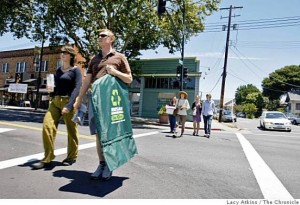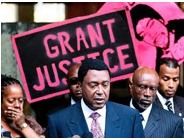Protecting What’s White: A New Look at Stand Your Ground Laws
By Sabrina Strings
I ran into a normally nocturnal neighbor early one morning. She was buzzing about with an uncharacteristic alacrity.
“Morning,” I muttered.
“Good morning,” she replied. She waited a few breaths before adding, “Did you hear the gunshots last night?”
“What? No.”
“Oh yeah! There were six gunshots fired last night. My Gawd. So scary! I’m not sure how safe our pantry door is, you know, the one that leads to the backyard? From now on, we have to keep our kitchen door locked—the one that leads to the pantry—to be sure no one can get in. We just need to be more careful. This area’s not safe.”
 The area to which she was referring was Temescal, a tiny slice of northern Oakland that borders South Berkeley. Its proximity to the Berkeley campus and its relatively inexpensive rent vis-à-vis Berkeley proper has made it a desirable locale for those UC-affiliated. In recent years, it has become a prime destination for young white families and hipsters, many of whom are fleeing from, or displaced by, the skyrocketing rents in San Francisco.
The area to which she was referring was Temescal, a tiny slice of northern Oakland that borders South Berkeley. Its proximity to the Berkeley campus and its relatively inexpensive rent vis-à-vis Berkeley proper has made it a desirable locale for those UC-affiliated. In recent years, it has become a prime destination for young white families and hipsters, many of whom are fleeing from, or displaced by, the skyrocketing rents in San Francisco.
My 20-something white neighbor was one such Oakland neophyte. And, if her sensationalized account of the gunshots being fired in the area was disturbing, the terror—tinged with more than a little titillation—that motivated her to react to the violence in the community by doing her utmost to protect herself and her property was telling. As beautifully articulated by my friend, Vicky, there was not one hint of regard for victim(s) of this gun violence, who were presumably black. Indeed, this young woman had already admitted to me on another occasion that she was “afraid of black men.” The shots fired seemed to validate this fear and her self-absorbed need to batten down the hatches of her property.
As I reflected on the creeping political bankruptcy of the Bay Area that gentrification has wrought, it occurred to me that her reaction should not be read as aberrant. In fact, in Oakland and other pockets of the Bay Area, there have been many recent examples of (mostly) white people in well-to-do communities endeavoring to protect their newly acquired property. In Temescal, new residents have hired private security firms to patrol the area. As reported in Colorlines, the private patrolmen often engage in tactics of racial profiling. And, if some people fear that their presence will lead to a rise in police brutality and alienation of residents of color, such concerns are not unfounded; at least one officer implied that the tactics of racial profiling will secure the area and “add value” to the surrounding environs, even as it displaces some of the long-standing residents.[1]
If I was surprised to realize that many white residents were working to secure, by any means necessary, their safety and the inviolability of their property, it was only because I had temporarily turned a blind eye to the reality that whiteness is property. This much was documented in the early 1990s by law professor Cheryl Harris in the landmark text, “Whiteness as Property.” Through an historical analysis of legislation that has been enacted over the past 200 years, Professor Harris demonstrated how the law has protected the rights of white citizens. This effectively made whiteness itself a right to be defended. The law has, moreover, “legitimized benefits that accrued to citizens just because they’re white.” [2]

If Professor Harris’s cogent analysis reveals how legislation and law enforcement prioritizes the rights and privileges of those deemed“white persons,” other critical race theorists have shown that the pressing need to safeguard whiteness against all presumed threats serves as a rationale for senseless violence against those not deemed white.[3] Indeed, the racial profiling, displacement, police brutality, and in some cases murder of (often) black persons, not just in Oakland (as in the case of Oscar Grant and many others), but nationwide, serve as critical examples of the seemingly justified violence against black people in the name of maintaining the sanctity of white privilege.[4]
In other words, when black people are believed to constitute a menace to the rights and privileges of white people, the imagined potential black-on-white violence serves as a justification for actual white-on-black violence, that not uncommonly ends in murder.[5] There is a word for the unfounded, pre-emptive, due-process-free (but tacitly sanctioned) form of killing perpetrated against black people in this country in an effort to safeguard white property: lynching.
It is convenient for us to believe that lynching forms part of the historical memory of racism in the United States. That, as many historians have revealed, it existed largely within the late-nineteenth to mid-twentieth century Jim Crow era[6]. That it served as a terroristic mechanism for protecting and defending the “purity” of the white race (defending, again, whiteness as a right to be protected). And, that these lynchings—not uncommonly of a black man accused of taking a liking to a white woman—had the tacit sanction of “anti-miscegenation” laws that proliferated after slavery, and made the sexual congress of black and white persons illegal[7].
The Civil Rights Movement may have de-legitimized widespread concern of maintaining the “purity” of the white race. And it may have been the motivation for the repeal of anti-miscegenation laws. But, there is no evidence that it de-legitimized or de-institutionalized whiteness as a form of property. Neither is there any evidence that it ended lynching as a brutal practice enacted for the maintenance of white property. At present, old concerns of “purity” have been shifted to the equally old and related concern of the benefits accrued to white persons. And there is a growing national trend of new legislation that serves to protect whiteness and its attached property through heightened safeguards and intensified instances of violence against black people: Stand Your Ground Laws.
The first Stand Your Ground law (SYG) was passed in Florida in 2005. [8] The success of the legislation was at least partially attributable to the public interest in the case of James Workman. Workman, a white 77-year old retiree who was living with his wife in his RV after Hurricane Ivan ravaged his Florida home, shot and killed a man who reportedly invaded his RV during the night. The man, Rodney Cox, was a white man from North Carolina[9] and a FEMA worker who had been dispatched to Florida during the relief effort. According to news reports, the NRA used the Workman[10] case as a lightning rod, in effect pushing for greater license to kill in the name of self-defense.[11]
But, if Workman put a rugged salt-of-the-earth face (and bootstraps name) to the Stand Your Ground legislation that aided in its appeal, the desire to safeguard white property against all those who might seek to molest it had been building in the national unconscious. According to a report by the National District Attorneys Association (NDAA), the rise of the new Stand Your Ground laws could be attributed to the growing concern of insecurity among American citizens that resulted from the combined onslaught of the 9/11 attacks (read: “Muslim terrorists”) and images of “lawlessness” (read: newly displaced poor and black persons) that flooded the news outlets in the wake of Hurricane Katina. Each of these events made “Americans” feel less “safe.”[12]
Although it was not reported in the NDAA analysis, one could argue—as I am doing herein—that the expansion of the democratic base and the two-time election of President Barack Obama (America’s first black President, per the laws of hypodescent!) was an additional motivation. A study of states adopting Stand Your Ground laws since 2005 published by Mother Jones reveals that the vast majority of states that have adopted these laws are in the South and Midwest.[13] A Gallup analysis of state voting patterns reveals that many of these same states are politically contentious, newly “purple” states that were once Republican strongholds.[14] The discourse among politicians in many of these states, like Florida and Texas, was that Obama’s election would lead to explosive growth of “entitlements” (a curious linguistic inversion) for the poor and elderly. Ultimately, the fear that the various institutions of the government simply could not or would not effectively protect the (imagined potential) white victims and their property was an impetus behind the adoption of these new laws.
This is evident in the racialized impact of Stand Your Ground laws, which have disproportionately authorized the murder of black citizens. A study released in August of this year by the Urban Institute reported that prior to the introduction of Stand your Ground laws, some 9% of white-on-black shootings were considered justified. Since 2005, in states that have adopted SYG laws, 17% of white-on-black shootings were adjudged justified. This compares to only 1% of black-on-white shootings in the same places.[15] Indeed, Florida-based statistics presented by the Tampa Bay Times show 73% of those individuals killing a black person walked away with no penalty. This compares to 59% of those killing a white person[16]. Per recent studies on SYG laws featured in Mother Jones,
“The greatest determining factor in whether your SYG claim will hold up is the race of the victim…homicides were ‘justifiable’ in 49 percent of cases in which a white man shot a black man compared to just 8 percent of cases in which the roles were reversed”.[17]
Because I’m a mixed-method researcher, let me also share some qualitative data. George Zimmerman’s murder of 17-year old Trayvon Martin was purportedly motivated by the number of recent break-ins in the area, and his frustration that, as his 911 call stated, “they always get away.”[18] 19-year old Renisha Davis was gunned down on a white man’s porch while seeking help after a car accident because, to hear the shooter tell it, he feared she was a potential home invader. As it pertains to the McBride case, filmmaker and activist Dream Hampton appeared on Democracy Now! to express her outrage that the media kept referring to the shooter as “the homeowner.”[19] Her indignation is justified. And yet, just like my neighbor, the media she was railing against operates under certain assumptions about the priority of white-landholding persons.
It is imperative that we discuss the growing number of black casualties as a trend, and not as random and unrelated instances of violence. Renisha McBride, Trayvon Martin, Darius Simmons, and countless other young black people gunned down in the name of property received no trial, no presumption of innocence. And as George Zimmerman’s Cheshire cat smile evokes painful memories of the shop owners wide grin after the Emmett Till verdict, it is important that we remember that the rationales for the two murders were not different. It was lynching then, and it’s lynching now.
Violence against black people in the name of white property—even in places like California, which does not have an SYG law—is an issue that must be addressed. But, the SYG laws (where adopted) provide the tacit legal sanction that, as the data show, only increases the likelihood of such crimes being committed. Stand Your Ground laws are, simply put, a form of institutional racism that sanction the murder of black citizens.
Democratic Senator Harry Reid[20] suggested we should let SYG laws remain a state-level decision. President Obama has come out against SYG laws, but little action outside of this public pronouncement has been taken. Early 2014 news reports suggest Florida is considering expanding its SYG law.[21] The proliferation of incidents of authorized violence against black people is a national issue. It took the Supreme Court decision in Loving v. Virginia in the 1960s to rule anti-miscegenation laws[22] as unconstitutional, and thus to undermine tacit authorization for lynching. We will need a similar nationally-binding solution to Stand Your Ground laws.
[1] Bogado, Aura. 2013. “In Gentrified Oakland, Private Security Takes Hold.” Colorlines. Nov. 1. Found online at http://colorlines.com/archives/2013/11/oakland_private_security_patrols.html
[2] Warren, James. 1993. “ ‘Whiteness as Property’: When Race Becomes A Right, Scholar Says It’s Time For `Corrective Justice.’” The Chicago Tribune. Sept. 5. Found online at: http://articles.chicagotribune.com/1993-09-05/features/9309050031_1_critical-race-theory-white-affirmative-action; Harris, Cheryl I. “Whiteness as property.” Harv. L. Rev. 106 (1992): 1707.
[3] See, for example: Roediger, David. 2002. Colored White: Transcending the Racial Past. University of California Press.
[4] Oscar Grant was an unarmed African American man killed by police in 2009. For more information, visit http://www.oscargrantfoundation.com/
[5] Oakland has one of the highest crime rates in the nation. But, this crime disproportionately impacts low-income communities (and residents) of color, and not the wealthier, largely white areas. UC Berkeley Law Professor Franklin Zimring recently noted that the crime “is concentrated in the areas of largest disadvantage, among minority populations–principally African-American and Hispanic…It’s not game-changing in most of the areas where the middle-class and upper-classes are concentrated.” He failed to designate these middle- and upper-class areas as having a higher population of white residents. Still, his analyses reveal that much of the crime committed in Oakland does not affect well-to-do (white) persons or communities. (see: Veshkin, Alison. 2013. “Oakland Crime Shows City Losing in California Rebound.” Bloomberg. Jan. 28. Found online at: http://www.bloomberg.com/news/2013-01-29/oakland-crime-shows-city-losing-in-california-rebound.html)
[6] See: “Lynchings: By State and Race, 1882–1968″. University of Missouri-Kansas City School of Law; Evans, Ivan Thomas. Cultures of violence: Lynching and racial killing in South Africa and the American South. Manchester Univ Pr, 2010.
[7] Brundage, William Fitzhugh, ed. Under Sentence of Death: Lynching in the South. UNC Press Books, 1997; Apel, Dora. Imagery of lynching: Black men, white women, and the mob. Rutgers University Press, 2004.
[8] The Stand Your Ground laws tremendously expand the rights to secure one’s property, for unlike the Castle Doctrine laws on which they’re built, in states adopting SYG the “victim” has no right to retreat, “defenders” have the right to use deadly force not only at home, but in public, and also have the right to use deadly force even if only one’s material property, and not their person, are being threatened.
[9] This story is eerily similar to the apocrypha surrounding Thomas Jefferson’s murder of a man (Rodney Cox from North Carolina) on the White House lawn. The Jefferson story is generally regarded to be a bit of urban legend.
[10] Workman too, in many news reports, is referred to as a “homeowner.” See: Montgomery, Ben. 2012. “Florida’s ‘stand your ground’ law was born of 2004 case, but story has been distorted.” Tampa Bay Times. Apr. 14. Found online at http://www.tampabay.com/news/publicsafety/floridas-stand-your-ground-law-was-born-of-2004-case-but-story-has-been/1225164
[11] California does not have a Stand Your Ground law, but it does have something similar. Under a California law that has existed for more than 100 years, an individual who fears death or bodily harm is not required to retreat. The difference is that under Stand Your Ground law, in Florida for example, “entitles the defendant to a pretrial, nonjury hearing at which the judge must dismiss the charges if the evidence shows it was more likely than not that the defendant was acting in self-defense” Moreover, in California, there is no mention of the right to defend material property in public. (See: Egelko, Bob. 2012. “Stand-your-ground the rule in state, courts affirm.” SF Chronicle. Apr. 15. Found online at: http://www.sfgate.com/crime/article/Stand-your-ground-the-rule-in-state-courts-affirm-3482665.php)
[12] See: Fisher, Marc and Eggen, Dan. 2012. “Stand Your Ground laws coincide with jump in justifiable-homicide cases.” The Washington Post. Apr 4. Found online at:
http://www.washingtonpost.com/national/stand-your-ground-laws-coincide-with-jump-in-justifiable-homicide-cases/2012/04/07/gIQAS2v51S_print.html; Jansen, Steven and Nugent-Borakove, M.Elaine. 2012. “Expansions to the Castle Doctrine: Implications for Policy and Practice.” The National District Attorney’s Association. http://www.ndaa.org/pdf/Castle%20Doctrine.pdf
[13]Staff writers. 2012. “See How Quickly “Stand Your Ground” Spread Nationwide.” Mother Jones. Jun 7. Found online at: http://www.motherjones.com/politics/2012/06/stand-your-ground-map
[14] Saad, Lydia. 2013. “In the U.S., Blue States Outnumber Red States, 20 to 12” Gallup Politics. Jan 30. Found online at: http://www.gallup.com/poll/160175/blue-states-outnumber-red-states.aspx
[15] Roman, John K. 2013. “Race, Justifiable Homicide, and Stand Your Ground Laws: Analysis of FBI Supplementary Homicide Report Data.” Urban Institute. http://www.urban.org/UploadedPDF/412873-stand-your-ground.pdf
[16] These statistics data did not include information on the race of the shooter. Hundley, Kris, Taylor Martin, Susan and Connie Humburg. 2012. “Florida ‘stand your ground’ law yields some shocking outcomes depending on how law is applied.” Tampa Bay Times. Jun 1. Found online at http://www.tampabay.com/news/publicsafety/crime/florida-stand-your-ground-law-yields-some-shocking-outcomes-depending-on/1233133
[17] Murphy, Tim. 2013. “GOP to Moms of Slain Black Sons: Stand Your Ground Laws Help Black People.” Oct. 29. Mother Jones. Found online at:
http://www.motherjones.com/politics/2013/10/gop-trayvon-martin-stand-your-ground-good-black-people
[18] Lave, Tamara Rice. “Shoot to Kill: A Critical Look at Stand Your Ground Laws.” U. Miami L. Rev. 67 (2013): 827-1039.
[19] See also: “Michigan prosecutors consider charges in Renisha McBride shooting” The Los Angeles Times. Nov. 12, 2013. Found online www.latimes.com/nation/la-na-renisha-mcbride-20131113,0,5934972.story
[20] See: Sullivan, Sean. 2013. “Everything you need to know about ‘stand your ground’ laws” The Washington Post. July 15. Found online at: http://www.washingtonpost.com/blogs/the-fix/wp/2013/07/15/everything-you-need-to-know-about-stand-your-ground-laws/
[21] Riggs, Mike. 2014. “Florida Might Revamp the State’s ‘Stand Your Ground’ Law.” The Atlantic Cities. Jan 14. Found online at http://www.theatlanticcities.com/politics/2014/01/florida-legislature-might-be-changing-states-stand-your-ground-law/8093/
[22] Scholars have suggested that while the peak period for lynching in the U.S. was roughly 1880s-1930s, there was a noticeable decline around 1968, after the Loving case (see: Lynchings: By State and Race, 1882–1968″. University of Missouri-Kansas City School of Law). Like anti-miscegnation laws grew out of the fear of black freedom (as a threat to whiteness), so too have the Stand Your Ground laws grown out of the fear that poor black people under the first black President are coming for “our property” (as a threat to whiteness). Each one has provided the tacit authorization for the crime of lynching.
________________________________________________
 Sabrina Strings has a B.A. with High Honors in Psychology from UC Berkeley and a Ph.D. in Sociology from UC San Diego. Her research examines the historical development of fat stigma in the United States, and its potential contribution to racial/ethnic and gender disparities in health outcomes. Her book manuscript, Thin, White, and Saved: Fat Stigma and the Fear of the Big Black Body, explores how body size has been used to maintain social hierarchies in the United States.
Sabrina Strings has a B.A. with High Honors in Psychology from UC Berkeley and a Ph.D. in Sociology from UC San Diego. Her research examines the historical development of fat stigma in the United States, and its potential contribution to racial/ethnic and gender disparities in health outcomes. Her book manuscript, Thin, White, and Saved: Fat Stigma and the Fear of the Big Black Body, explores how body size has been used to maintain social hierarchies in the United States.
A former McNair Scholar, Sabrina has received awards for her research from the African and African American Studies Research Center, the Ujima Network, and the American Association of Blacks in Higher Education. Her recent publications include “She is Not Acting, She IS: The Conflict Between Gender and Racial Realness on RuPaul’s Drag Race,” which appeared in Feminist Media Studies. Sabrina is a UC Berkeley Chancellor’s Postdoctoral Fellow with a joint appointment in the School of Public Health and the Department of Sociology. She is currently working on a project that investigates the social and environmental factors contributing to obesity and adverse health outcomes among women of color.





Pingback: Wednesday Open Thread [2.5.14] : Delaware Liberal